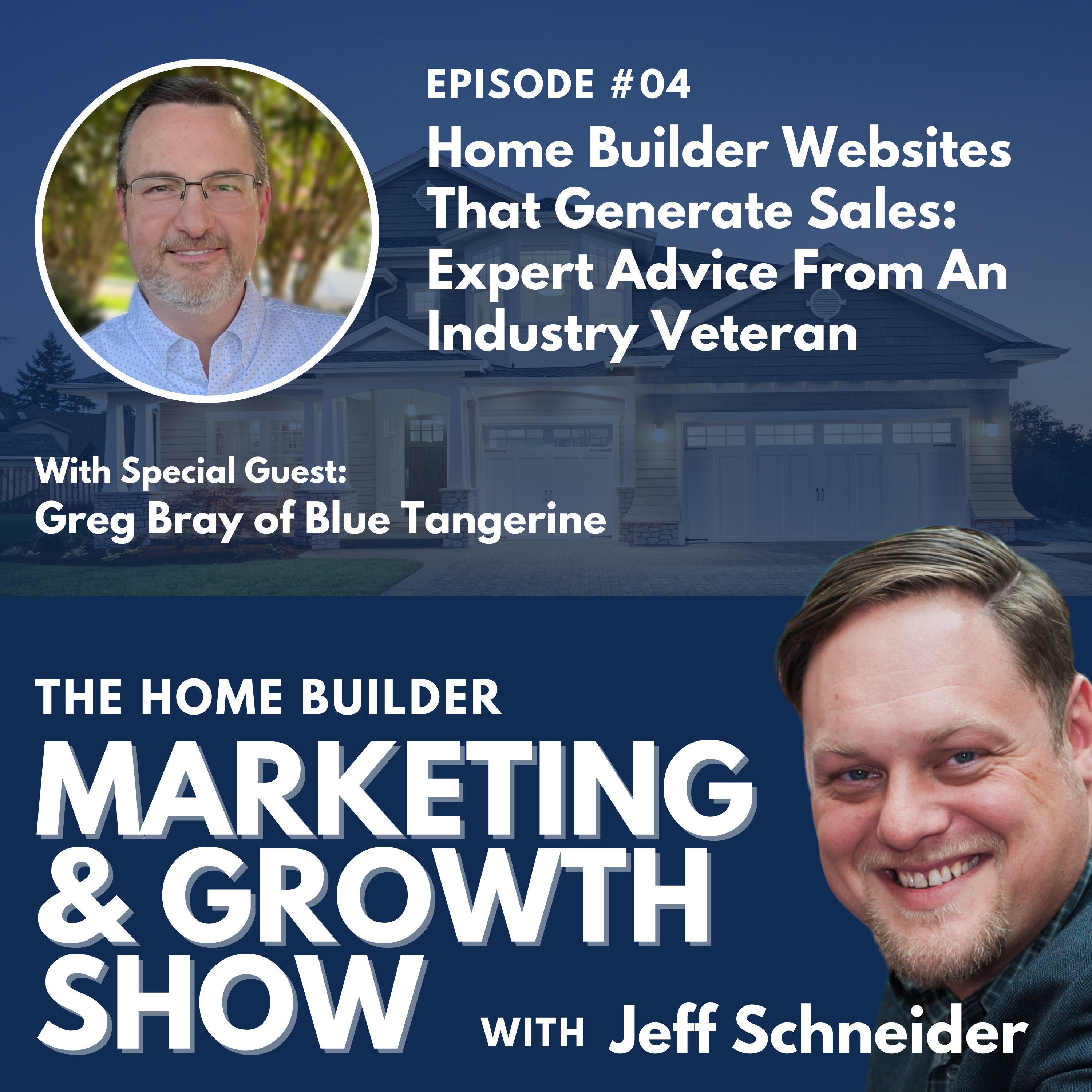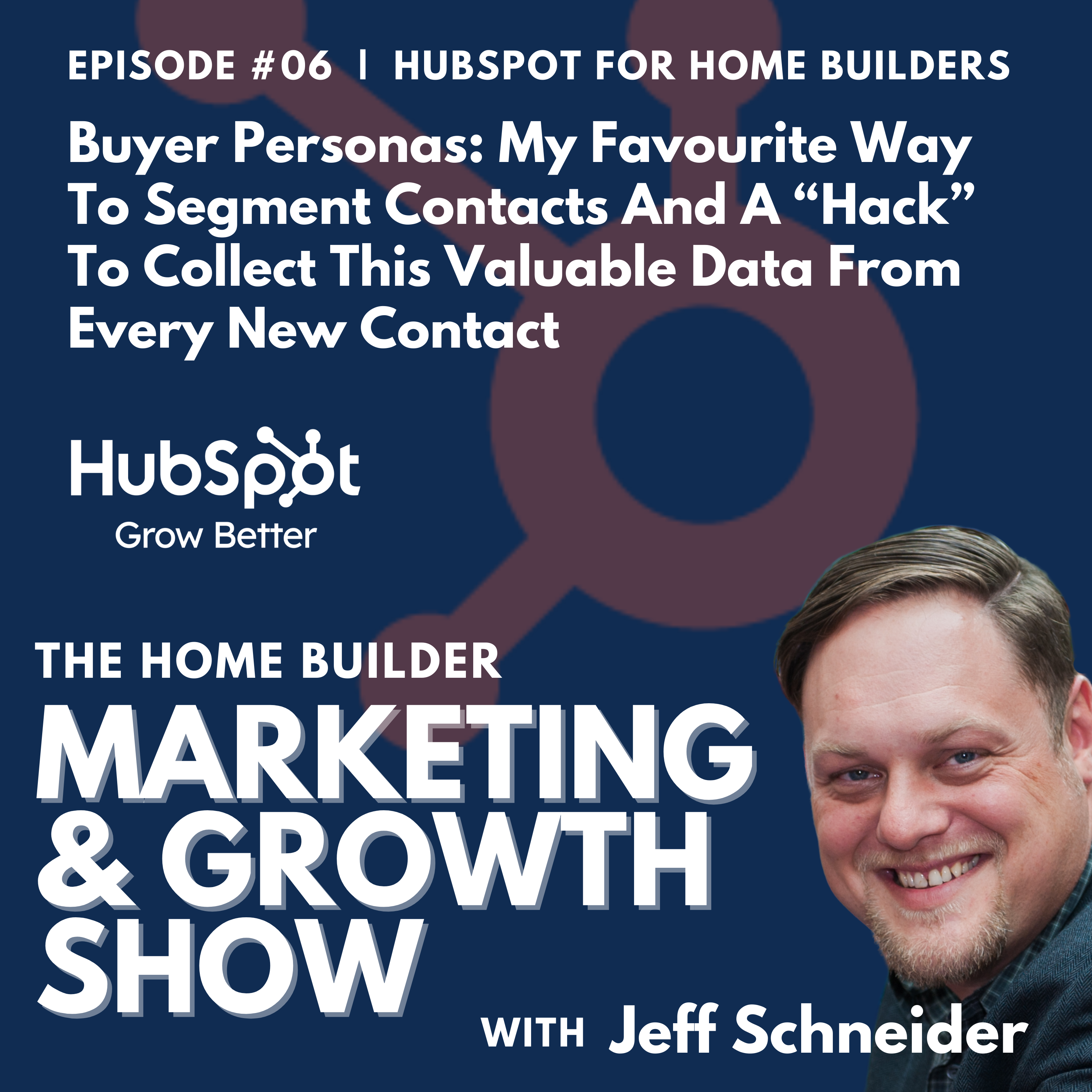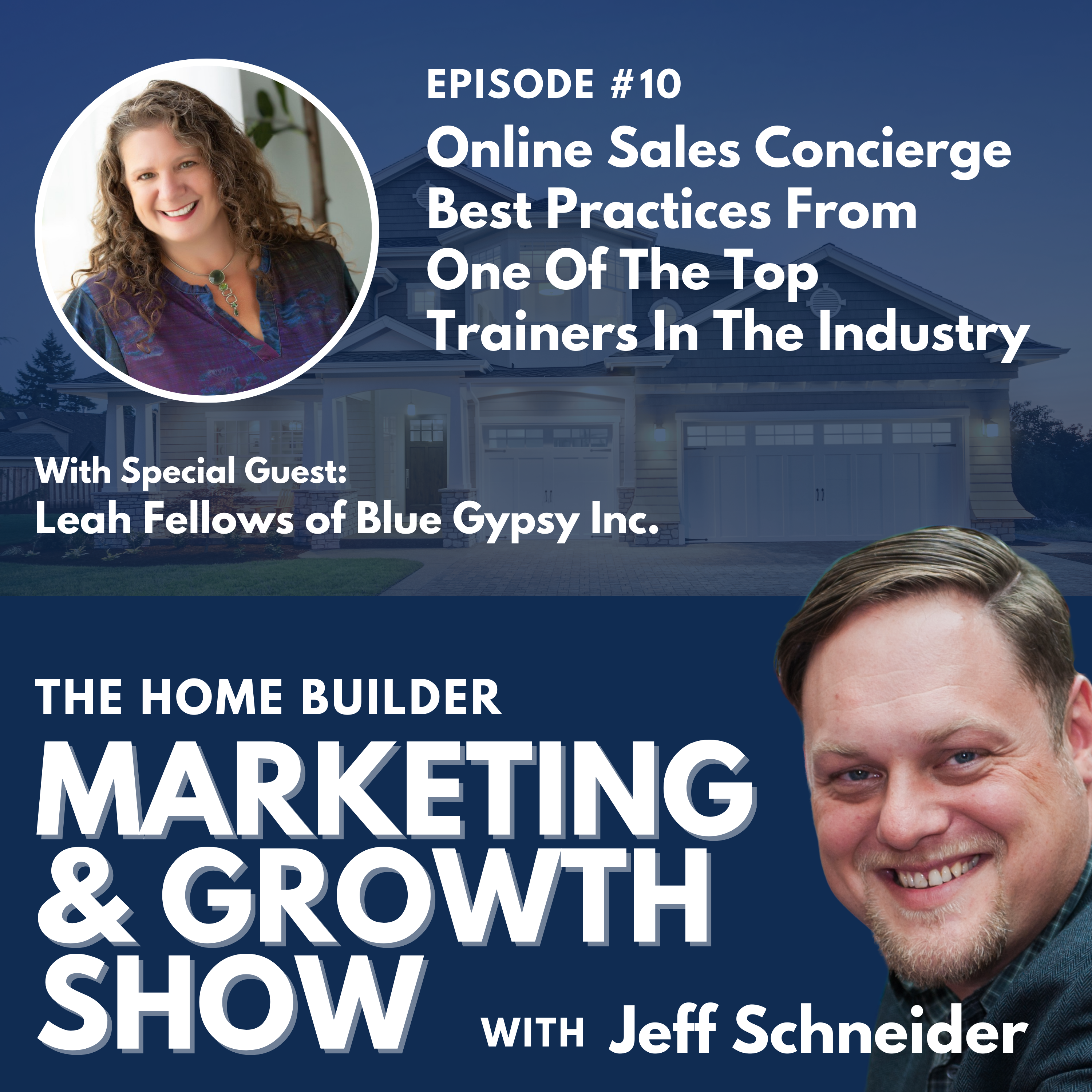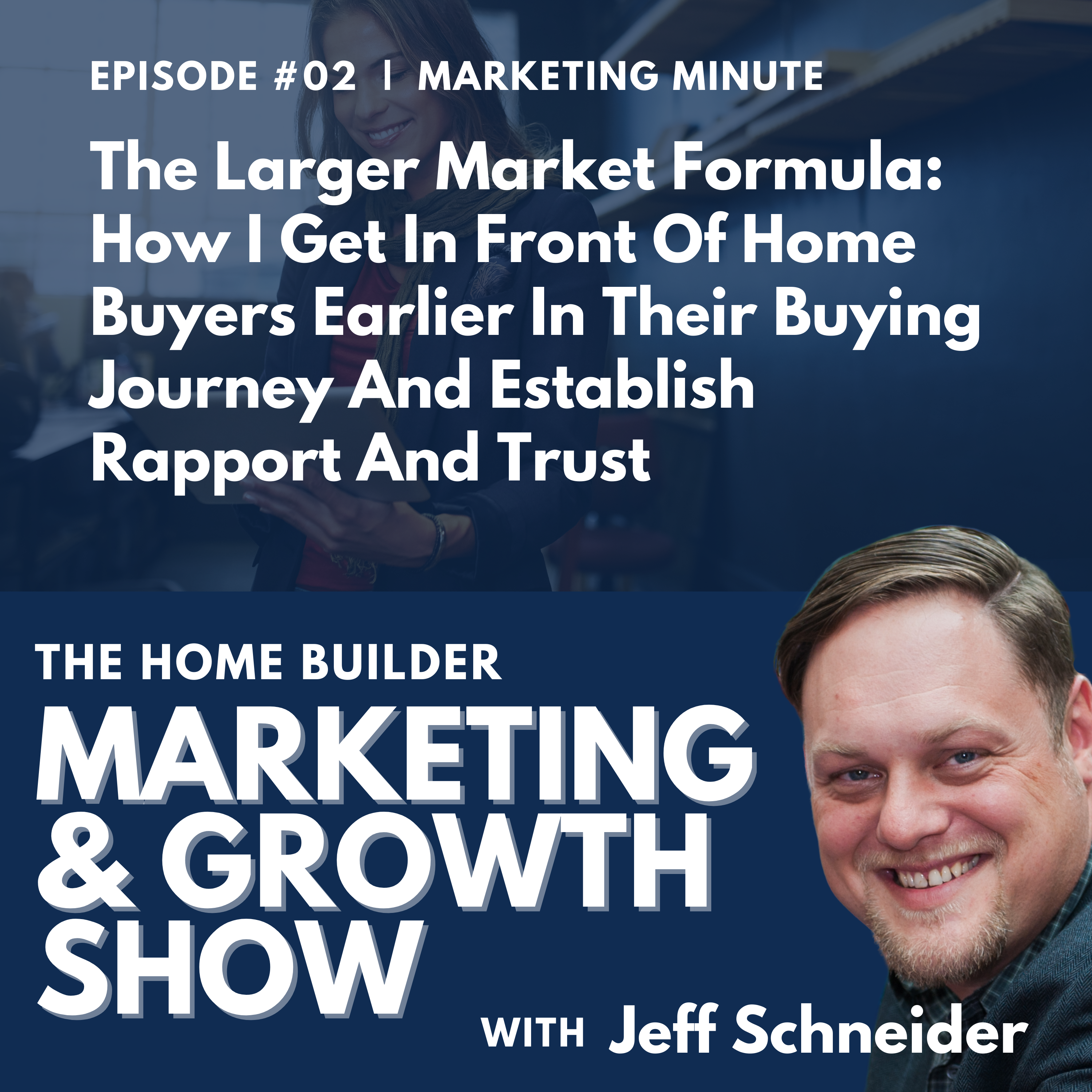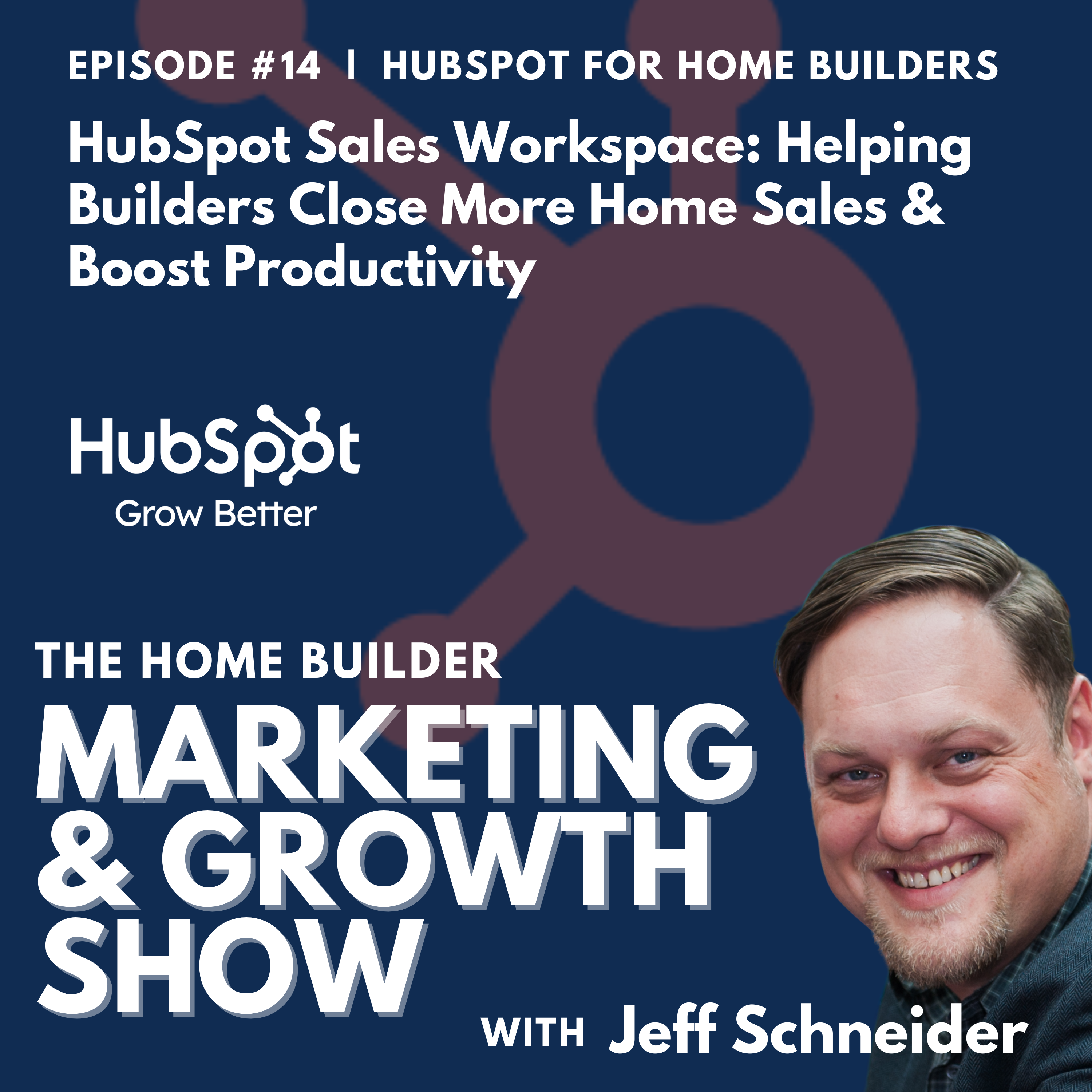Episode Transcript
[00:00:00] Imagine a world where your ideal clients come to you already half sold on a home. Sounds too good to be true, doesn't it? But it's not. Top home builders are using an underutilized tactic that's revolutionizing their marketing buyer Personas. These aren't just fancy marketing buzzwords, they're the key to unlocking unprecedented growth in your company. And when you have your buyer Personas dialed in, you'll slash your marketing costs, increase your conversion rates and fill your pipeline full of eager, qualified leads. Are you ready to leave your competition in the dust and become the go to home builder in your market? In this episode, I'm going to show you how to create and leverage buyer Personas to transform your marketing. So don't let another day of hit or miss marketing slip you by. Let's dive in and build your foundation for marketing success. Hey, it's Jeff, and welcome to another episode of the Homebuilder Marketing and Growth show. In this mini segment, we're going to be talking about buyer Personas. Now, I admit that early in my marketing career, I kind of scoffed at buyer Personas. I was just eager to get into the tactics and build out the campaigns and do all the fancy stuff. That's way more exciting than trying to create a fictional character of who I want to sell homes to. But as time went on, I learned the real power and impact on your marketing success that having well documented buyer Personas can really have. So what is a buyer Persona? It's a semi fictional representation of your ideal customer. They help you understand and relate to your target audience, and they also help align your marketing, sales and product development efforts. So what are the key elements that make up a buyer Persona? Well, there's a number of them. The first one, and probably the most important, is the stage of life of that particular target customer. So are they early on in their life and just getting ready to buy their first home? Are they later in life getting ready to move up? Maybe they've outgrown their home? Or are they towards the golden years in life and their kids have left their home and they're getting ready to downsize. So knowing their stage of life is one of the most important pieces of creating a really good buyer Persona. Now further to that can also be the product type that they're interested in. So are they interested in a duplex or a townhome, or a condo apartment, or a single family home? Are they interested in a custom build? So, understanding what type of product that your ideal customer is looking at can also be a really important element in building out a complete buyer Persona. Another key component of your buyer Persona is going to be your demographic information. So this is things like age range, family status, marital status, number of kids, that kind of statistical information. Then you have psychographic information, and this is things like values, character, beliefs, interests. Then the next element that you have is their goals and their challenges as it relates to your product. Another element that you have is what is that? Buyer Personas preferred communication channels and content types. And then lastly, what are their decision making factors and potential objections? So these elements all make up a buyer Persona. So how do buyer Personas differ from general target demographics? This is a question that comes up a lot. Buyer Personas often have a lot more depth to them than broad demographic information. They also provide a lot of context and emotional insight into how that particular Persona thinks and acts. And then lastly, buyer Personas oftentimes have a storytelling aspect to them that make them more relatable. All right, so let's dive into how to create effective buyer Personas. Let's talk first about the different research methods that you can use to gather Persona data. So in my opinion, the number one method for gathering buyer Persona data is leaning on your sales team for their insights and feedback. So as they're talking with prospects and sitting knee to knee in the show home or the sales center, they're going to pick up on a lot of information that can be very valuable to you in creating your buyer Personas. So, for example, they might be having a conversation about how many rooms do they need in their house, how many bedrooms do they need? And that prospect might share with them how many kids they have? And then the salesperson can say, oh, are they in school? Like what grades are they in? Well, now you've captured some key information around family status, and then there's obvious ones that your salespeople can capture as well, such as visual demographics, like ethnicity or family status or marital status, information like that. Another common question is, you know, what do you do for a living? And when you start talking about careers and that sort of thing, it's an easy question to ask, oh, that's a really interesting career. Did you have to go to school for that? Well, now you've got educational status or educational level. So there's a lot of information like that that your salespeople can pick up on. And demographic information is the easiest for them to collect. But you can also use your salespeople to collect a psychographic information. Psychographic data. So, questions around lifestyle and beliefs and interests that kind of information comes up just in normal everyday conversation. So as they start understanding their prospect a little bit more and asking detailed, good questions about what they're looking for in their new home, that sales rep can get a better understanding of what their lifestyle is really like. Do you do a lot of entertaining? You know, do you have a lot of family coming in from out of town? Do you need to have a spare bedroom? Do you work from home? Do you enjoy cooking? What are your needs and requirements for your kitchen? And so they can start to gather that information around prospects, interests and lifestyle and things that are important to them that way. And again, just record that information in your CRM system. Another method that you can use to gather more demographic and psychographic information around your buyer Personas is using quiz funnels. This is a relatively new method, and I haven't seen a lot of home builders capitalize on this method. What you can do is have a lifestyle quiz. You know, what is your new home personality? And so visitors on your website answer a series of questions and then the quiz gives them a result, you know, a fun little category or segment that they put them into so that they can better understand what their new home personality is. And again, that could be things like you're an entertainer or you're the master chef, or you are, you know, the intellect or whatever categories you decide to put in place. But you learn information from the questions that those people answer in that quiz. And depending on what softwares you use, you can then move the responses to those questions and store them into your CRM system in that contact record. So that can help you build out your Persona information.
[00:06:52] Another thing that you can do is you can conduct a series of customer interviews and surveys and directly ask people this information. Now, this method is a little bit more difficult. And what I would encourage you to do is if you are going to do a series of interviews or surveys, you need to provide some value for people's time. So that could be the form of, hey, complete this short survey and we'll send you a gift card, something like that. You can easily write that off against your marketing budget. The reason why that's important is because people's time is valuable. And if you take a step back and you look at that proposition, there's nothing in it for the person that's completing the survey. You're not giving them anything for it, but there's everything in it for you as the builder. And so you need to compensate people for their time. And this is a really popular method that a lot of, in the tech industry, a lot of tech review sites will offer people gift cards to complete a survey or fill out information and leave a review about software that they've used. That's how they build up their reviews and build up their content around the different software systems that are available to people. So definitely make sure that you're aware of your ask and that you're valuing people's time. Now, another method that you can use are things like your website and social media analytics. This is a little bit harder to do because obviously a great buyer Persona is made up of information around people that are actually buying or that have bought. That's going to be the most valuable data to create your buyer Persona. Whereas your website analytics and your social media analytics are more made up of everybody that follows you or everybody that visits your website, whether they're a qualified prospect or not. So that isn't as good of a source of data as reaching out to your customers directly or having your salespeople gather that information as they go through the sales process. And lastly, you can draw on things like market research and industry reports to help collect data and fill in some of the blanks. But there again, that's even lower quality data because it's not even specific to you and your company. So those are all the various methods that you can use to collect the data that you need to build out an effective buyer Persona. Okay, so now that we've collected our data, how do we turn that into actionable Personas? The first thing that you want to do is identify any commonalities or any patterns that you're seeing in that data. You want to group together information and put it into buckets or segments so that it makes logical sense. And you can do that using spreadsheets or Google Docs, whatever makes the most sense for you. So once you've collected and segmented that data into buckets, what you want to do next is start to build out your actual buyer Persona worksheets. So you can do a Google search looking for buyer Persona template and start to fill in the information for those buyer Personas on those worksheets. Now, keep in mind here that our objective is to create a character sheet, a fictional description of who would be buying our home. Another thing that you can do is utilize storytelling techniques to really round out your buyer Personas and bring them to life that helps the characters or the buyer Personas feel real and relatable. So you can tell short stories about their career path, or what life is like at home, or what their current struggles and challenges are in their current home and what they're looking for in a new home and create story around that. Once you have your buyer Persona drafts done, the next step is to have some internal workshops with your team in order to refine those Personas. So have a meeting, and everybody sits down and reviews those buyer Personas and offers their insights and feedback on them. Take everyone's feedback into consideration and then refine those buyer Personas until you have something that you're really happy with. You want to have a nice, polished, well rounded buyer Persona. And then the last step is giving your buyer Persona a name. We like to use fun names. We use things like move up Mary and downsizing Diane and realtor Ron. Things like that, so that they're short and snappy, easily memorable by your team. And so that when you're talking about a buyer Persona in your marketing or with your sales team or your product development team, when you talk about that buyer Persona by their name, everybody knows who you're talking about. All right, so let's talk about some common pitfalls to avoid when you're developing your buyer Personas. The number one mistake that I see marketers make around buyer Personas is waiting until they're completely finished before they implement them in their marketing. That's the worst thing that you can do because oftentimes creating a buyer Persona on the list of urgency and, you know, important needs and tasks in the marketing department, creating a buyer Persona is usually towards the bottom. However, it's very important. Like we've talked about, it can definitely be a game changer in your marketing. So don't wait until you have completed buyer Personas in order to start using them in your marketing. In fact, the only piece of information that you need to have in your buyer Persona before you implement them is their stage of life and or product type. That's the number one key piece of information that you need in order to start using them. And the reason for that is that depending on a buyer Persona's stage of life or the product type that they're interested in, their information requirements are completely different. What I mean by that is somebody who's getting ready to buy their first home, maybe they're renting, and they've never purchased in their life. Their needs for information and the research that they have to do to get comfortable and get prepared for making a buying decision are completely different than somebody who's living in a home that they currently own and getting ready to move up, or they're getting ready to downsize into a smaller home later on in life. So that should be your primary segmentation for your buyer Personas. Once you have people in those buckets, you can start marketing to them because you know what their information needs are. You have a better idea of what their buying journey looks like and you can start creating marketing messaging around that that's gonna resonate with those buyer Personas. Another common pitfall is over relying on assumptions rather than data. So we see this all the time in marketing. You'll think that you know what keywords somebody uses in order to find your website, or you'll think that you know what the best layout for a landing page is. And then when you test it and you get that data, you understand that you were wrong. And it happens to everybody. It doesn't matter how long we've been doing what we've been doing, we're oftentimes proven wrong. And so rely on the data, don't rely on your assumptions. So you can start using your buyer Personas with some assumptions around some of that data. That's okay, but don't leave it at that. What you want to do is make sure that you gather that data to prove that you are correct or to fill it in with the factual information that you maybe overthought. Now, another common pitfall is creating too many buyer Personas. So oftentimes we get too granular with it and we start looking at all the different variations of the data that we've collected, and we create too many segments. So don't get hung up on the quantity of buyer Personas that you have. The fewer the better. And the reason for that is, the number one thing that we're using our buyer Personas for is our marketing, messaging, the content that we create. And so for each buyer Persona that we add, we have to create additional marketing for that buyer Persona that speaks to them. So don't get tied up in the granular bucket things a little bit more broadly, if you can. Again, like I said before, your main buckets for your buyer Personas should be stage of life and product type. Beyond that, there's going to be variations in a lot of that data, but as long as you put them into those maintain segmentations, you'll be good. Another pitfall that I see is builders trying to create their buyer Personas with the main segmentation of psychographics. So how someone thinks or where they're at in their career or their lifestyle, that sort of thing. I don't believe that psychographics is the main segmentation you should use for buyer Personas because it doesn't make sense. You can have somebody that is a move up buyer and their information needs are all generally the same. Move up buyers all have the same information needs, but can have varying different lifestyles. Some people are, you know, home is the sanctuary and they look forward to, you know, that bath at the end of the night and having a quiet place where they can read a book and unwind from a busy day. And other people love to entertain. They just always have a household or a house full. But they're both move up buyers, so creating your segmentations, bye. Psychographics doesn't make sense. The other thing is that you can have two prospects that share psychographics. Maybe they're both entertainers. They love to have company and be the life of the party. Well, one of them could be a first time buyer and another one could be a move out buyer. And again, like we talked about, the information needs for both of those Personas are vastly different. So don't use psychographics as your main segmentation factor. So another common pitfall is focusing entirely on the positive attributes and ignoring the negative ones. In order to have realistic and well rounded buyer Personas, we need to understand that there are negative pain points involved in this. The clearer we understand what someone's pain is with their housing problem, the easier it is for us to speak to what the solution is. People are more motivated to make a purchase based on eliminating pain than they are to increasing joy. As an example, what I mean by that is marketing is more impactful when you talk about how somebody can eliminate a pain or a problem than it is when you talk about the opportunity for gain. So that said, it's important to make sure that we do incorporate the pain points that these buyer Personas are experiencing. And the last pitfall that I see is that oftentimes once home builders create their buyer Personas, they don't ever update them. Markets change, you're in and out of new communities, you've got different home models that you're creating, and so keeping your Personas updated should be something that you do on a regular basis. This is a lot easier to do if you're really leveraging your salespeople for gathering that demographic and psychographic information as they work with prospects. If they're entering that information into a CRM system, you can then utilize reporting tools to pull a report, build some charts, and build some visuals to understand where your demographics are today. And you'll see that over time they will shift and change now, again, we don't have to completely overhaul our buyer Personas, especially if we're making sure that our main segmentation is based on that stage of life and product focus. I can't stress that enough. That is the number one way that you want to make sure that you segment your buyer Personas. All right, now let's talk about how the rubber meets the road. How do we leverage buyer Personas in our marketing? The most powerful way that you can utilize buyer Personas in your marketing is by customizing your messaging to your buyer Personas. So once you've got your buyer Personas completed, the first step that you should do is map the home buying journey. And so the home buying journey, we're all familiar with it's awareness consideration decision. And in the awareness stage, people are first becoming aware that they have a housing problem. In the consideration stage, they've made up their mind that they're going to be buying a home and they have a lot of questions and a lot of research that they need to do in order to make a smart buying decision for their lifestyle and for their stage of life. And then in the decision stage, they've made up their mind that they're going to buy a new home and they're starting to shortlist builders and understand who they want to build with. And there's a lot of questions around that as well. So when you map out that buyer's journey, what you want to do is you want to record the key questions that people are asking throughout all three of those stages. And again, when we're focusing on our different buyer Personas, the key questions and the research points that that buyer Persona needs to do is going to be different depending on stage of life and depending on product focus. So once you have your buyers journey mapped out, you want to start to develop content that answers those questions and helps those buyer Personas to overcome their challenges and understand how to reach their goals. And when you create that personalized content around that buyer Persona, what that allows you to do is create long term nurturing campaigns. We all know that prospects come into contact with our companies at various stages of the buyer's journey. And we all recognize that nobody goes out on a weekend, nobody wakes up on a Saturday and goes, my home doesn't work for me anymore. And when they come home at the end of the day, they've got a signed contract. That never happens. The buying journey is many months long, sometimes many years long depending on your buyer Persona. What we need to do is stay in front of those buyer Personas in a way that we are an invited guest and not an annoying pest. And the way to do that is to make sure that we're delivering value in our marketing so that people look forward to and actually enjoy getting our marketing because it's helpful. It helps them to do their research and make faster and more informed decisions. And so we utilize content like blog posts and emails and social media in order to reach out and educate our buyer Personas and stay front of mind with them and help them through all of those different decision points along their buying journey. Another way that you can leverage Personas in your marketing is by creating value propositions specifically for that buyer Persona. So again, when you understand the needs, wants, challenges, goals of a buyer Persona, you can speak to that in your marketing. And when you do that, that buyer Persona, what happens in their head is they go, holy, these people get me. They understand where I'm at, they know the challenges that I'm dealing with. And it resonates with them on a different level than just act before the end of the month and save $10,000 on your basement development. So it repositions your marketing and changes the relationship between your company and all your competitors. And then the other way that you can leverage this in your marketing is adjusting the tone and the language that you use so that it resonates more with your buyer Personas. So a younger audience who's getting ready to buy their first home, they have lingo and they have different language that they use than an empty nester would. And so cautiously, you can utilize this in your marketing. And again, it just makes your company more relatable and helps them to see a fit with you over a different competitor. Another way to leverage Personas in your marketing is using your Personas to identify which channels you're going to use for your marketing. So for example, a move up buyer or maybe a custom home builder, you might be better off reaching those people on LinkedIn, whereas a younger, first time buyer audience, maybe you're better off attracting them on Instagram or Facebook or TikTok or whatever other channel that you're focusing on. So understanding who your buyer Persona is and where they spend their time online is going to help you be more effective with your marketing. The other thing that you want to do is align your campaign planning around that particular Persona. So when you understand their behaviors and their actions and information like that, you can fine tune your campaign so that it really relates with that Persona. For example, if you know that you're targeting custom homebuyers and they tend to be on Facebook late at night and LinkedIn during the day. Well, you can time your campaign or time your posts that you're publishing to go out on those channels during the times that that buyer Persona is most likely to be there. And another really useful way that you can utilize Personas in your marketing is with ad targeting. And this admittedly has gotten harder over the last few years. But in some cases, with some software, you can still upload lists of contacts and run campaigns against that list. So as an example, if you're using, say, HubSpot or another CRM like that, you can create a list of contacts that are that particular buyer Persona. You can then upload that list to one of your different networks that you want to run targeted ads on and then create your ad copy that speaks directly to that buyer Persona. So rather than targeting everybody in your CRM system with the same general broad marketing, you can fine tune your ads to speak directly to that buyer Persona and what their needs and wants are. All right, so how do we measure our success and refine our efforts? When it comes to using Personas in our marketing, the first thing that we want to do is set metrics and KPI's that align with that particular Persona. So for example, we might be looking at open rates for emails. Older demographics might have higher email open rates than younger demographics. So understanding what our goals and what our benchmarks are there is going to be important to understanding how successful that campaign actually is. Another thing that you should be doing is using a b testing or split testing to optimize your campaigns for each Persona. So for example, if you have a landing page where you're offering a free download about a new community or a particular type of home model or whatever it happens to be, you want to make sure that you a b test or split test that landing page. And so what that is, for those that aren't aware of it, is you create two different copies of that landing page and then you split your traffic 50 50. So that half goes to one page and half goes to the other page. And what that does is gives you an idea of which page has a higher conversion rate, how many people filled that form out on that landing page. So there's lots of different softwares out there that will handle this for you. But what it allows you to do is just get an idea of what is connecting with your market and what isn't and then keep using your a b testing or your split testing in order to continually optimize your conversion rates. For that Persona. And of course, we're talking about success and we're talking about KPI's and metrics. You need to have the right analytics tools in place so that you can measure those conversion rates and see what is actually hitting and what's not. So utilizing software like HubSpot that's got built in analytics, you can utilize Google Analytics. There's lots of different analytics tools out there that you can use, but make sure that you are tracking those metrics and making sense of the data so that you can ensure that you are being successful with your campaigns and you are being successful with your efforts to optimize those campaigns and get greater conversion rates. And then lastly, we want to make sure that we're updating our buyer Personas based on our findings from this data. So going back to that example of creating two different versions of a landing page for a specific buyer Persona, when we see that one page is converting at a higher rate than the other one, it's important to understand why. And when we understand why, maybe that's different text or different copy on the page, we need to record that information in a way that we are continually updating what is effective for that particular buyer Persona. All right folks, so that is buyer Personas in a nutshell. I hope you got a lot of value out of that. I just want to stress once again, this is the biggest takeaway from today's session. If you only take away one thing, take away this. Your key segmentation for your buyer Personas should be stage of life and or product type. That is the number one segmentation that you want. The second key takeaway from today's session is make sure that you map your home buying journey so that you can create content specifically related to that buyer Persona. That will give you the capability to do long term lead nurturing. So that when you capture a lead and they're not ready to buy today, they don't get thrown in the trash or forgotten about. You can nurture them for the long term, provide value for the long term, and then when they are ready to buy, guess who they're going to come to. And the third major takeaway from today is don't wait to get started until you have completed buyer Personas. Understand that initial segmentation of stage of life or product type. And once you have those buckets created, those categories created, get using them, get started right away. You can build the rest of your buyer Personas out as you go and refine them as you go. But all you need to get started with buyer Personas is understanding that stage of life and or product type fit. So again, thanks for tuning in. Hope you enjoyed this episode. If you got a lot of value out of it, please consider subscribing to the show. Share it with a colleague. The show is new still. We're trying to build the audience and we want to get the word out there. So anything you can do to help us with that, we greatly appreciate it. Thanks so much for tuning in. Love you guys. We'll see you on the next one.

